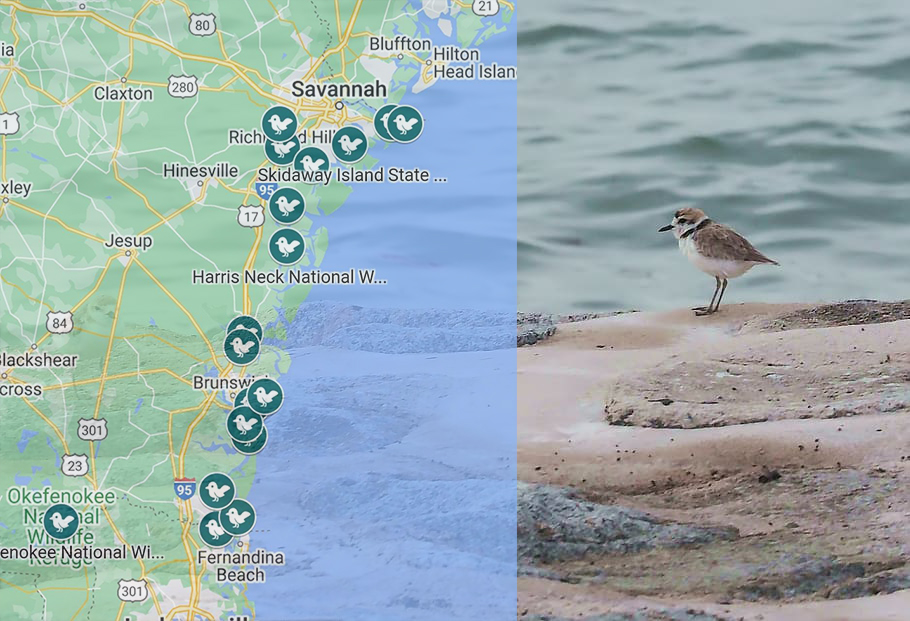
Wildlife biologist Tim Keyes of the state Department of Natural Resources said spring is when “even ordinarily drab birds look their best.” The 17 sites on the Colonial Coast Birding Trail offer an entryway to this world of color. “The trail encompasses all the diversity of habitats and bird species the Georgia coast has to offer,” Keyes said.
With spring migration ramping up, millions of birds from warblers to shorebirds and even insects such as butterflies and dragonflies are returning to their breeding grounds. Three sites that exemplify the variety of the birding trail and the region’s rich wildlife and history are Fort Pulaski National Monument, Harris Neck National Wildlife Refuge and Jekyll Island’s South End Beach.
Fort Pulaski National Monument near Savannah covers 5,600 acres at the mouth of the Savannah River and includes Cockspur and McQueen’s islands and the adjacent salt marsh. This is an excellent place to spot migratory songbirds such as warblers and tanagers during spring. Clapper rails, seaside sparrows and marsh wrens can be seen or heard in the marshes around Fort Pulaski throughout the year.
Shorebirds can best be seen along the shoreline at high tide. The beach at Fort Pulaski, created as part of Savannah shipping channel maintenance, provides additional roosting sites for birds. Fort Pulaski is also fascinating relic of the Revolutionary War, with nearly 200 years of history on display.
Moving south, visitors at Harris Neck National Wildlife Refuge near Townsend can explore more than 2,700 acres of saltwater marsh, freshwater impoundments, mixed deciduous forests and open fields. Harris Neck has the largest wood stork colony in the state, and includes many other nesting wading birds, as well.
Spring is an excellent time to see nesting birds interacting with their young. The refuge is even one of only two sites in Georgia where roseate spoonbills have been confirmed nesting (though not annually). Woody Pond on the refuge offers excellent opportunities to see and photograph wading birds. For painted buntings, one of the more colorful migrants, check out the feeders at the refuge offices and shrubby habitat around Harris Neck in late spring.
For more beach birding, the South End Beach on Jekyll Island near Brunswick provides excellent chances to see congregating shorebirds and seabirds. It is very common to encounter thousands of birds resting on the edge of the water. (But please don’t disturb resting birds: Give them a wide berth.) This is also the island’s primary nesting area for Wilson’s plovers in spring and summer, so watch for chicks being corralled by their parents. Most Wilson’s plover nesting areas are roped off and marked with signs.
To access the South End Beach, park at St. Andrews Beach Park or the Jekyll Island Soccer Complex (Glory Beach Access) and walk south. From either location it is a little more than a half-mile. The St. Andrews route is not accessible during higher tides. Please also follow ordinances concerning dogs on the beach.
Whether you want to watch a wood stork feeding its fluffy young, follow the twitchy movements of the Wilson’s plover or search for elusive saltmarsh sparrows in the reeds, the Colonial Coast Birding Trail has something for you in the spring.
All told, some 300 species of birds – 75 percent of the species reported in the state – have been seen at trail sites. The trail also features opportunities to see other wildlife, including big alligators, croaking frogs and hanging Spanish moss.
Learn more at georgiabirdingtrails.com and on DNR’s Go Outdoors GA app. The free app, which allows you to check off species seen on the trail, can be downloaded at the Apple or Google Play store.
DNR’s Wildlife Conservation Section works to conserve Georgia’s top wildlife viewing areas and all wildlife not legally fished for or hunted, as well as rare plants and natural habitats. The agency does this largely through public support from fundraisers, grants and contributions.
Key fundraisers include sales of the eagle and monarch license plates, and annual renewal of these and older designs such as the hummingbird. The tags cost only $25 more than a standard plate to buy or renew. Up to $20 of that fee goes to help wildlife. Supporters also can donate at gooutdoorsgeorgia.com. Click “Licenses and Permits” and log in to the secure system. (New customers will need to create an account.)
Details at georgiawildlife.com/licenseplates and georgiawildlife.com/donations. Visit georgiawildlife.com/conservation/annualreport to see how your support is put to work.


Bulloch Public Safety
06/23/2025 Booking Report for Bulloch County

Bulloch Public Safety
06/30/2025 Booking Report for Bulloch County

Bulloch Public Safety
7/14/2025 Booking Report for Bulloch County

Bulloch Public Safety
7/11/2025 Booking Report for Bulloch County

Bulloch Public Safety
7/09/2025 Booking Report for Bulloch County










